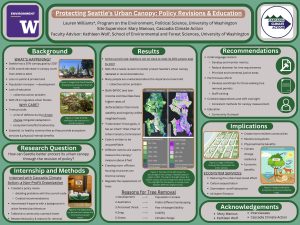Protecting Seattle’s Urban Canopy: Policy Revisions & Education
Urban forests are an integral part of community health and well-being, especially during climate change. They provide an array of benefits to climate change mitigation, adaptation, and community resilience. But, as populations increase, and more individuals move to urban settings, the urban canopy becomes increasingly threatened. This poses challenges for decreased community and ecological prosperity as changes in weather and climate patterns become more volatile. Protecting trees in urban settings has and will continue to be a challenge without effective policy implementation. The purpose of this study is to understand the most effective methods for protecting Seattle’s urban canopy through the implementation and revision of policy. In order to do this, I read the Seattle Municipal Tree Code (SMC) 25.11 and spoke with four individuals who have history working with the code. I also found comparable cities to Seattle with a more thriving urban canopy, and began reviewing their cities’ tree codes finding differences in language and implementation. Through my research, I found there to be gaps in the objectives of SMC 25.11 and the results seen within the urban canopy. To better implement the goals of the code, more consideration needs to be placed on code language, enforcement, and education surrounding the invaluable assets trees provide. It’s important to understand the methods for most effectively protecting the urban canopy to combat climate change while addressing environmental justice.
